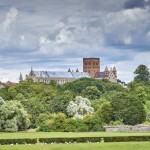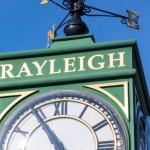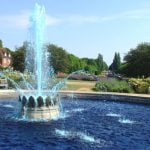Our Five Minute Whirl Around Chelmsford
The City Built on Roman Ruins.
Chelmsford is an Essex city with more than 110,000 people. While that number seems high, it’s actually smaller than some of England’s larger towns. No matter! This city has been in existence since the Romans invaded Britain circa 40AD. Let’s jump into all that fascinating history and see where it leads.
Join us, for the Five Minutes Spare whirl round Chelmsford. You are sure to find out a few interesting things that you didn’t already know…
Roman Chelmsford
Roman Chelmsford wasn’t called Chelmsford, it was called Caesaromagus. Somehow, a fort all the way across the sea from Rome, had managed to inherit the great name of Caesar. Nobody knows why, either, as the origin story has been lost to time.
We do know that there has been a mansion uncovered in dig sites throughout the area, and that several small settlements existed around it, all throughout history. It is thought that the site was built around 60 AD and that it represented a halfway point between the forts at both Colchester and London.
The very last of the Romans were gone by around 400 AD – that is to say that they shipped back home again in response to threats to the Empire. Some stayed because they had families here by that point. It’s unsure who lived in the mansion that was discovered under the Moulsham area. We do know that the town was a fortified one in the 2nd century AD. We also know that this would have been the peak of the Roman good times.
When they left, they left thousands of abandoned wooden homes behind them. Chelmsford would have been all but abandoned. It is thought that the real Chelmsford became an official settlement in the middle ages, many, many years after those first settlers to the area. It is also widely agreed that it would have been formed when several smaller settlements grew to merge together[i].
Middle Aged Chelmsford
The first recorded inhabitants in Chelmsford after this is in the Domesday Survey. Even in 1086 it was in the county of Essex. It had a grand total of 4 households, making it one of the smallest recorded settlements in the land survey ordered by King William the Conqueror. There was also only one registered owner… the land belonged to the Bishop of (St. Paul) London.
Although there weren’t many people there was a whole load of land. What this usually means is that there was an estate in place, where many of the workers would have lived and been employed. An estate, no matter how big, would only be counted as a single household. Other reasons to suspect an estate is the presence of 30 acres of meadows with 3 lord’s plough teams, and one extra team made of local men. The three lord’s teams likely lived on an estate. They also owned (and this is some list):
- Woodland containing 300 pigs. We’re not sure if they counted them all or just guessed.
- A working mill, presumably for grinding flour.
- 2 cattle… It is not recorded which type of cattle.
- 27 pigs. We are pretty sure they counted these ones.
- …And 100 sheep.
The land was making the Lord Bishop around 8 pounds a year. A princely sum. Probably because the invading Normans didn’t (for the most part) take land from the church. The land was owned by the same people as it was before the invasion, allowing uninterrupted growth… of sheep and pigs, apparently.
Since the Bishop of London already owned the land, he went ahead and built a bridge across the river Can on it. Now that there was a bridge in place, the Roman’s original theorised plan of Chelmsford being an important passing place could go into motion.
Let’s talk about the etymology for a second. We know that it was Caesaromagus at one point, and then that it was a very small settlement. We also know that towns with a ‘fjord’ often ended up with a ‘ford’ at the end. We didn’t know where the ‘Chelm’ came from. However, Wikipedia have it as a derivative of ceolmaer. A Ceol was a flat-bottomed ship, ‘maer’ was likely an adaptation of ‘mere’, which was the Old English word for a body of water.
Old English is neat fun, actually. If you want to play around with the translator you can find it here. So Chelmsford just means there is a place in the water where only flat-bottom ships can pass. Probably because it was too shallow.
On to the fun stuff.
Fun Facts from Chelmsford
There are loads of fun and interesting facts about Chelmsford out there. We picked the Five Minutes Spare favourites for you, so you don’t have to look hard for them.
- Danbury Common, a nearby recreational parkland/moor, has the biggest known adder population in Britain. It has the biggest reptile population of any random heathland in Britain.
- They held witch trials in court here in 1566. A woman confessed to sending a cat named Sathan to hurt people? What a weird story. She did time in prison for it but was hanged later on a different witch hunt. The 1600s were a weird time, evidently.
- There is an island where the two rivers meet that locals call Mesopotamia.
- Chelmsford has been a capital of England, so have a lot of other cities – but Chelmsford wasn’t a city until 2012. So it was capital of England – but still a town. It may be the only one of those.
People also always love to talk about Chelmsford being the birthplace of radio. However, we have it on good authority that video killed the radio star. We will leave you to make up your own minds, safe in the knowledge that Chelmsford is a very weird place. Weird enough for young women to name their cats Sathan.
More Medieval Stuff
Around the turn of the 11/12th century, the bishop that owned the land was given loads of other rights by the King, including charters to hold fairs and attract merchants and craftsmen. They would hold an annual fair for a full weeklong, allowing people from all over Essex to trade. There was a thriving textile industry even back then. As the two cattle became many cattle leatherworking and skinning took a leap. Later, wool and cotton would be woven here.
Drapers, Mercers, and dyers were common in the streets. The friars came at some point in the 13th century and started a leper colony, which made them incredibly popular with the locals. In the 1400s a priest named William Caleys was burned to death. He was accused of heresy and was associated with the Colchester Lollards. According to Britannica online this was a derisive term for a person who followed the teachings of John Wycliffe. Their ideas were incredibly similar to the protestant reformation but that was still a while away. You could say they were before their time.
Some time around the 12th century, the town became an assize. This was a court held at intervals in each county of England. The court allowed laws to be upheld throughout England and remained up until 1972, when the high court system took over. Notably, the town was the scene of a peasant’s revolt in 1381, eventually forcing the king to intervene and sing charters. The area of the town in which the revolt leaders were hung is now known as Primrose Hill. It’s probably haunted so bad luck for you if that’s where you’re staying.
Henry VIII bought the Boleyn estate circa the 16th century, he built a grammar school after closing all the friaries. Later, his mistress lived there, who became his wife, and also his daughter moved in… really it was all a big messy scandal. Although the next few years would see plague hit Chelmsford over and over again; it kept growing. By the time we reach the modern era (or the 18th century, at least) it would have had a population of less than 5,000 people. It was still a small place…
The Industrial Revolution, the expansion of the rail system and the addition of a few canals, however, and the town grew to gargantuan proportions in only 200 years.
The Industrial Revolution and Modern Era
Chelmsford thrived in the 18th century. A jail was built at the end of the century, accompanied by a new bridge and a shire hall. An improvement commission was then set up to overs the lighting, paving, and cleaning of the streets. Several outbreaks of plague led to sewer works, piped water, and other amenities coming into town – but this would not be until after the railway entered town in 1843.
Gas street lighting, a hospital, and a park in the town centre were all added in this same time period. The first radio station was opened in Chelmsford in 1899, which is why it is widely agreed that radio was born here. Widely regarded as the form of entertainment that drove the evolution of modern media; the city of Chelmsford has a lot to be thanked for.
Fifty years on from the arrival of the railway, the population of Chelmsford had swollen some 600%. Now above 22k, the town was extended, a library was opened, and retail establishments opened up. By the time of the First World War[ii], Chelmsford had grown large enough to significantly contribute to the formation of the Essex buddy regiment. This led to the loss of nearly a generation, for whom a memorial still stands.
During WWII, Chelmsford was a fairly important centre of manufacturing and engineering. The then-town was bombed by the Luftwaffe. One of the worst incidents saw 50 people dead in 1943. Another in 1944 saw a rocket hit Henry Road, and 39 people died. On many other occasions the residents were left homeless by the bombings. An interesting note is that the site of the modern V Festival was once where a prisoner of war camp stood. Grizzly.
Let’s leave it there, on such a pleasant note, to glance at some of the famous people that have come from the fair city of Chelmsford. We still have the attractions to cover too, so if you are looking for the best things to do in Chelmsford? Stick around!
Famous People out of Chelmsford
This cracking city has had its fair share of famous people passing through, moving there, or coming from there. Let’s take a look at some of the Five Minutes Spare favourites:
- Joe Thomas, the actor who plays Simon in Inbetweeners, comes from Chelmsford.
- Internationally acclaimed artist Grayson perry is from Chelmsford.
- The freestyle skier Gus Kenworthy was born in Chelmsford.
- Model and photographer Penny Lancaster also came from this town.
As a whole, Chelmsford features a rich variety of choice in terms of famous faces. From acting talent to beautiful voices and gorgeous faces, its contribution has been no less than excellent. Let’s skip ahead to the best things to see and do in Chelmsford before we go any farther[iii].
Top Chelmsford Attractions
There are loads of things to see and do in the heart of Essex. Don’t forget that London is only a hop, skip and jump away by train, too. With that in mind, here are our top voted attractions in Chelmsford…
Historic Sights and Landmarks
Interestingly, the second-smallest cathedral in England resides in the city of Chelmsford. The size of it is still impressive, it’s just smaller than others. The architecture is also suitably impressive and is one of the best free sights to visit in town. Chelmsford cathedral makes great Instagram background shots. Of course, those who enjoy religious services can go along and worship there.
The Hylands Estate resides in the middle of the renowned Hylands Park – that’s right, the one that used to hold the prisoner of war camp in 1944. Now it is the backdrop to many a day out, and at least one music festival. The building itself is grade II listed and beautiful to tour.
Lastly, try to stop by the Boreham Airfield War Memorial. During the wartime years, the SAS had their command centre in the area. Combined with the huge loss of life in terms of sacrifice this city made during both wars; it is only fair that we give them the respect they are due.
Football and Recreation
The local team are Chelmsford City FC and they play at Melbourne community stadium. You can find them there at the weekend playing, through the week training – or can just book a stadium tour. They do a lot of community work on top of housing the football team.
For leisure facilities, you ought to visit the Riverside leisure centre – which contains its very own ice rink. That’s right, you can ice skate for your exercise if you live in Chelmsford!
Retail and Shopping
You have several rather glorious options for shopping experiences in Chelmsford. Try the Bond Street stores first of all. This was the sight of the first John Lewis department store in Essex, has its own gallery and cinema, and is worth an afternoon or two perusing the shops. Similarly, you will have loads of choice if you visit the indoor High Chelmer Shopping Centre. With more than 80 stores, this is the Chelmsford version of an American mall.
Outdoor and Recreational Activities
If you have kids and are looking for a day out in Chelmsford – then look no further! The first stop on free days out with kids is the Central Park, Bell Meadow, and Sky Blue Pasture attraction in the centre of the city. This is a piece of Green Belt space that allows the city to stay peaceful while simultaneously preventing urban sprawl. Visit for a picnic, a hike, or a nice walk through the meadow on a pleasant sunny Sunday. You also have Hylands Park as a good picnic choice. It means you can get the photos you want of the Estate, without having to pay for a tour.
If you prefer well kept and orderly gardens, then visit the RHS Garden Hyde Hall. This place contains all the most beautiful plants able to grow in this region and makes for a pleasant day out. They have a tearoom, too, should you want a high tea… and of course, the hall itself is stunning.
We can’t let the moment pass without giving a nod to Chelmsford City Racecourse, either. Whether you want to spend an afternoon at the races – or whether you just want to see how the other half live – this is where you do it. You might even win a bet or two…
Museums and Galleries
Some of us travel for the museums… just joking, but if you want to visit some and educate yourself then Chelmsford is a good starting point. Chelmsford City Museum is probably the most visited in the area. Here, you can learn all about the evolution of the town and how it came to be what it is today.
If you don’t want that kind of history thrown at you, try the Essex Police Museum. The county police are apparently proud of their heritage… such as it is. You can go along and learn all about the local bobby. Better yet, take the little ones. They love a good policeman/woman to look up to – and so do we!
Where to Eat, Drink, and Party in Chelmsford?
You are almost up to speed on all the best things to do in Chelmsford – but where do you get a good meal and a reliable pint? For family feasting, check out Schwings. They do international street food with a flavoursome twist. The Anchor Riverside Pub and Restaurant is an equally good place to take the family.
The Ivory Peg is reportedly the home of the cheapest pint in the city centre. If you prefer a cocktail bar then try Be at One, which locals love for a Friday or Saturday night. If you would rather listen to overly loud music and dance the night away than drink, you might find what you are looking for in London – just kidding – try the Bassment… see what they did there?
Other Notable Sights in Chelmsford
There were some other important sights we though you should visit in Chelmsford – even though we couldn’t cover them all in detail. Here are some of the other notable attractions you should see if you are in town:
- The Civic Theatre – if you are in need of a show, some contemporary dance, or some youthful drama classes, visit the Civic.
- Mace Playce – got kids? Looking for things to do in Chelmsford that are soft, feature a play area, and where you can let the kids burn off some energy? This might be it.
- The Meadows Shopping Centre – in case you haven’t shopped enough yet…
So as you can see, there are some interesting things to get up to is you are in the Chelmsford area. A fact that is only likely to get truer them ore this new city grows.
How to Get There?
After all of this, you are probably as excited to visit as we are. We looked up how you go about getting there, to save you having to plot a journey on the map.
By Road
Chelmsford is on the A12 heading north and east out of London.
By Rail
Chelmsford Railway Station is on the Greater Anglia line.
By Air
Your nearest airport is London Stansted but you are close enough to the city to have your pick.
By Sea
The river Chelmer is probably the nearest you can get to travelling to Chelmsford via waterways.
Got Five Minutes?
If our five minute whirl around Chelmsford piqued your interest, then you will probably enjoy some of our other work. You can check it out by heading to our pages and having a good old nosey around. We can’t promise you’ll find what you’re looking for, but we can promise you will have a little fun while you are searching.
[i] www.localhistories.org/chelmsford.html
[ii] www.essexregiment.co.uk/exlw1.html
[iii] https://www.thefamouspeople.com/chelmsford-1780.php




